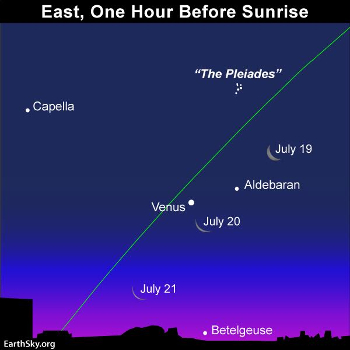|
Moon and Venus closest morning of July 20 |
|
July 19, 2017 |
By Bruce McClure
EarthSky.org
Before sunrise on July 20, 2017, look for the
waning crescent moon and planet Venus in the
eastern morning twilight. Or if you’re up before
dawn, say an hour or two before sunrise, then
let the predawn darkness show you the star
Aldebaran and the Pleiades star cluster as well.
Although Aldebaran ranks as a 1st-magnitude star
– and the Pleiades is highly recognizable for
its dipper-like shape – both pale next dazzling
Venus. Thus the light of the coming dawn can
drown them from view.
Venus – the most brilliant planet – ranks as the
third-brightest celestial body to light up the
heavens, after the sun and moon. Venus shines
nearly 100 times more brilliantly than Aldebaran,
the brightest star in the constellation Taurus
the Bull.
Our sky charts are designed for mid-northern
North American latitudes. But don’t let that
stop you from looking! No matter where you are
on Earth, simply look for the moon in the
eastern sky before sunrise, and the two starlike
objects close by on July 20 will be Venus and
Aldebaran.
 |
| If you’re up
early enough, the predawn sky will show
you the star Aldebaran and the Pleiades
star cluster around now. The green line
represents the ecliptic – the sun’s
annual pathway in front of the
constellations of the zodiac. |
Need more precision? Residents of the world’s
Eastern Hemisphere – Europe, Africa, Asia,
Indonesia, Australia and New Zealand – will see
the moon offset to the west (farther away from
the sunrise point) relative to Venus and
Aldebaran.
We in North America see the moon to the east of
Aldebaran on July 20. People in far-eastern
Asia, Indonesia, Australia and New Zealand will
see the moon to the west of Aldebaran on this
same date.
But if you live in India, Pakistan or
Afghanistan, it’s possible that you won’t see
Aldebaran to the west of the moon – or to the
east of moon in tomorrow’s July 20 predawn/dawn
sky.
That’s because the moon will actually occult
(cover over) Aldebaran in this part of the
world, with Aldebaran slipping behind the moon’s
illuminated side and then reappearing from
behind the moon’s nighttime side.
Around the world on July 20, 2017, the moon and
Venus will be close in the east before dawn. The
bright star nearby is Aldebaran in Taurus the
Bull. If you catch them long enough before
sunrise, you might also see the dipper-shaped
Pleiades star cluster above Venus, the moon and
Aldebaran. |
|
Questions or comments about this
article?
Click here to e-mail! |
|
|
|
|

